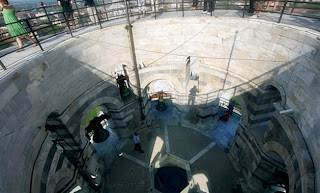Leaning Tower of Pisa (Italian: Torre pendente di Pisa or abbreviated Torre di Pisa) is the campanile or bell tower of the cathedral in Pisa, Italy.
Tower of Pisa is actually made to stand vertically like a bell tower in general, but began leaning shortly after construction began in August 1173. It is situated behind the cathedral and is the third building Campo dei Miracoli (Field rainbow) city of Pisa.

The height of the tower is 55.86 m from the lowest ground level and 56.70 m above the highest ground. Width of the wall below it reached 4.09 m and 2.48 m at the top. Its weight is estimated at 14,500 tonnes. Tower of Pisa has 294 steps. With the tower, sector revenues due to the econ
omy was growing attraction.
Tower of Pisa is also accepted as a UNESCO World Heritage Site.
In Italy a lot of old buildings are amazing one of them is this tower of pisa. The tower is so famous Karene bangunanya tilted up to 5 meters. Here's a brief history of how the tower pisa built.
Leaning Tower of Pisa (Italian: Torre pendente di Pisa or abbreviated Torre di Pisa) is the campanile or bell tower of the cathedral in Pisa, Italy.
Tower of Pisa is actually made to stand vertically like a bell tower in general, but began leaning shortly after construction began in August 1173. It is situated behind the cathedral and is the third building Campo dei Miracoli (Field rainbow) city of Pisa.
The height of the tower is 55.86 m from the lowest ground level and 56.70 m above the highest ground. Width of the wall below it reached 4.09 m and 2.48 m at the top. Its weight is estimated at 14,500 tonnes. Tower of Pisa has 294 steps. With the tower, sector revenues due to the economy was growing attraction.

Construction of the Tower of Pisa is in three phases within a period of 200 years. Construction of the first floor of the white marble campanile rocky start on August 9, 1173, which is an era of prosperity and military success. The first floor is surrounded by pillars with classical letters, leading to skewed against arch blinds.
construction of this tower is to put a big clock on the tower. However, some time after construction began, it was 55 meters high tower was deviated from a straight line along the 5 meter. That is why the tower is known as the leaning tower of Pisa. Until now, the efforts of the engineers and experts various countries, the slope of the tower has been repaired to a certain extent.
After the third floor was built in 1178, the tower began to tilt as the foundation stands on unstable land. Finally, the design of the tower is much different than the original plan. This development was also delayed for 100 years because the people of Pisa at that time fighting with people from other regions. But, because that's delayed, the tower can actually survive. If not suspended, maybe even the tower would fall.
In 1198 several clocks placed on the unfinished building. Approximately 74 years later, architect Giovanni di Simone went on the construction of minarets.
Not long after, the construction was again stopped because there was a war. Finally, in 1372 so it was also the last floor which was a bell and a bell was installed there. The development is carried out by a different architect, which Tommasso di Andrea Pisano. He managed to combine elements of this Gothic bell indoor Roman style. In the tower, there are about seven bells. The biggest bell is installed around 1655.
From this tower, appears unique stories and also makes excited. For example, astronomer Galileo Galilei was dropped two balls of different weight of the tower. This is to show that the reduced velocity of the second ball was not because of the weight. But this story also reportedly fairy tale.
However, what really happened was an order from the Italian authorities at that Benito Mussolini ordered that the tower be returned to a vertical or upright position. To carry out the order, given the additional concrete tower foundation. Apparently, the results are not as expected. Tower added even sink into the soft soil.
When World War II, the U.S. military almost destroyed the Tower of Pisa is also for fear of snipers there. Fortunately, the withdrawal of troops to save the tower.
There is controversy regarding the identity of the architect of the Leaning Tower of Pisa. Over the past several years designers predicated to Guglielmo and Bonanno Pisano, a prominent local artists in the 12th century Pisa, which is popular by bronze molds, particularly in the Pisa Duomo. Bonanno Pisano left Pisa in 1185 leading to Monreale, Sicily, only to return home and died in his hometown. The sarcophagus was found at the base of the tower in 1820.
You're reading an article about Leaning Tower of Pisa, Italy and you can find this article url Leaning Tower of Pisa, Italythis url
http://chicabi-uniquearchitecture.blogspot.com/2013/01/leaning-tower-of-pisa-italy.html. You may distribute or copy this article Leaning Tower of Pisa, Italy This is beneficial if you or your friends, but do not forget to put the source link.

No comments:
Post a Comment